Colorado’s arid climate presents challenges for homeowners who want beautiful xeriscape landscapes without sky-high water bills. Traditional grass lawns demand irrigation, fertilization, and maintenance – a costly cycle that fights against nature’s design.
This comprehensive guide features 10 xeriscape design templates, plus expert guidance on selecting the perfect template for your property’s unique conditions.
These professionally crafted plans provide plant placement, spacing guidelines, and seasonal structure tailored specifically for Denver’s climate zone. Simply download, follow the layout, and watch your yard transform into a sustainable oasis.
What Are Xeriscape Design Templates?
Xeriscape design templates are created landscape blueprints engineered for low-water use in arid and semi-arid climates.
These detailed plans specify exact plant placement, sun and shade orientation requirements, soil compatibility factors, and proper spacing measurements for optimal growth.
Each template eliminates the trial-and-error approach that often leads to plant failures and wasted investment. The designs incorporate plant for xeriscaping that provide seasonal interest throughout the growing season, from spring emergence through winter dormancy.
Templates also address practical concerns like maintenance access, growth patterns, and long-term sustainability.
Expert Tip: Templates simplify DIY landscaping for first-timers and homeowners working within tight budgets, providing professional-level planning without consultation fees.
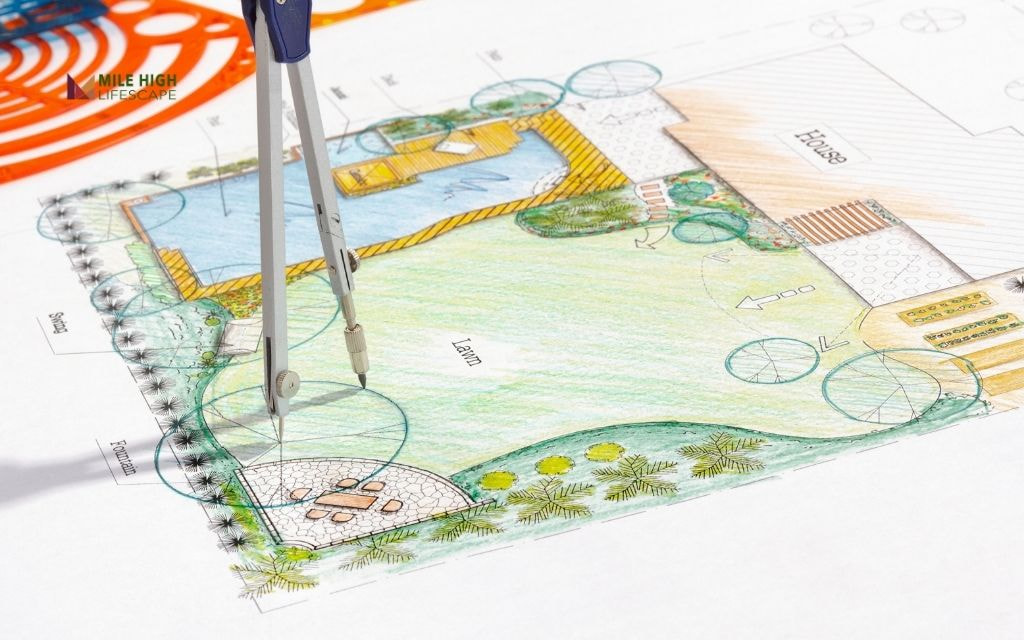
Key Features of a Good Xeriscape Landscape Design
Effective xeriscape templates incorporate specific elements that ensure long-term success in Denver’s challenging climate conditions.
- Water zones and hydrozoning form the foundation of smart xeriscaping. Quality templates group plants with similar water needs, creating distinct irrigation zones that prevent overwatering drought-tolerant species or underwatering transitional plants.
- Low-maintenance plant groupings reduce ongoing care requirements (pruning, deadheading,…) Professional templates select species that complement each other’s growth habits, bloom times, and mature sizes.
- Soil-appropriate species selection addresses Denver clay soils and alkaline pH levels. Quality templates specify plants that thrive in these conditions rather than requiring extensive soil amendments.
- Year-round structure and visual interest ensure landscapes remain attractive through all seasons. Templates incorporate evergreen shrubs, ornamental grasses, and plants with interesting bark or seed heads that provide winter appeal when herbaceous perennials enter dormancy.
- Color and bloom succession planning creates continuous garden interest from spring through fall. Professional templates sequence flowering times to ensure something remains in bloom throughout the growing season.
- Defined paths, borders, and hardscaping zones provide structure and functionality. Quality templates incorporate non-plant elements like mulched walkways, decorative rock areas, or small patio spaces that reduce planted area.
- Pollinator and wildlife support reflects modern ecological awareness. Contemporary templates include native species that support local bee populations, birds, and beneficial insects, creating landscapes that contribute to regional ecosystem health.
[Free] 10 Xeriscape Design Templates For Your Yard
#1: Front Yard Pollinator Garden
This front yard template transforms traditional turf areas into thriving pollinator habitat and maintains curb appeal that satisfies neighborhood standards.
The design features carefully selected native perennials and ornamental grasses arranged in flowing drifts that mimic natural prairie patterns.
Best For: Full sun exposures, small to medium front yards (500-1,500 square feet), and HOA-compliant xeriscaping requirements. This template works particularly well for homeowners who want to support local wildlife while reducing maintenance demands.
Key plants include:
- Purple Prairie Clover
- Penstemon
- Blue Grama grass
The design incorporates seasonal bloom succession from spring Pasque Flowers through fall-blooming asters, ensuring continuous color and pollinator resources.

#2: Low-Water Backyard Entertaining Zone
This backyard template combines hardscape entertainment areas with placed ornamental beds, creating functional outdoor living space that requires minimal irrigation.
Best For: Medium to large backyards where entertainment and relaxation take priority over extensive planting. This template suits families who want outdoor gathering spaces without traditional high-maintenance lawns.
The plan includes defined patio zones using permeable pavers or flagstone, surrounded by drought-tolerant plantings that provide privacy screening and seasonal interest. Buffalo grass or blue grama alternatives replace traditional turf in smaller, functional areas.

#3: Shade-Friendly Woodland Edge
Urban properties often feature significant shade from mature trees or neighboring structures.
This specialized template addresses these challenging conditions with drought-tolerant plants that thrive in partial to full shade environments.
Best For: North-facing yards, tree-lined properties, or areas receiving less than 6 hours of direct sunlight daily. This design particularly benefits homeowners dealing with competition from established tree root systems.
Featured plants include Coral Bells, Creeping Mahonia, and Wild Ginger – species that provide color, texture, and seasonal interest while tolerating both shade and drought conditions.

#4: Parkway Strip Conversion Design
Narrow parkway strips between sidewalks and curbs present unique landscaping challenges, including road salt exposure, foot traffic, and restricted planting depth. This template addresses these constraints and creates attractive streetscape improvements.
Best For: Urban homeowners required to maintain parkway strips or those wanting to eliminate grass mowing in these difficult areas. The design works well for properties with HOA requirements for maintained frontage.
The template features low-growing, traffic-tolerant species like Yarrow, Blue Grama grass, and decorative mulch zones that provide visual appeal while withstanding urban stresses. Installation requires minimal soil depth and establishes quickly.

#5: Slope Stabilizer Design
Sloped properties face erosion challenges that intensify during Colorado’s intense but infrequent rainfall events.
Best For: Hillside properties, backyards with significant grade changes, or areas experiencing erosion problems. This design particularly benefits homeowners dealing with drainage issues or soil movement.
The plan emphasizes deep-rooted native grasses, spreading groundcovers, and low shrubs that bind soil while requiring minimal water inputs. Species selection focuses on rapid establishment and long-term soil stabilization performance.
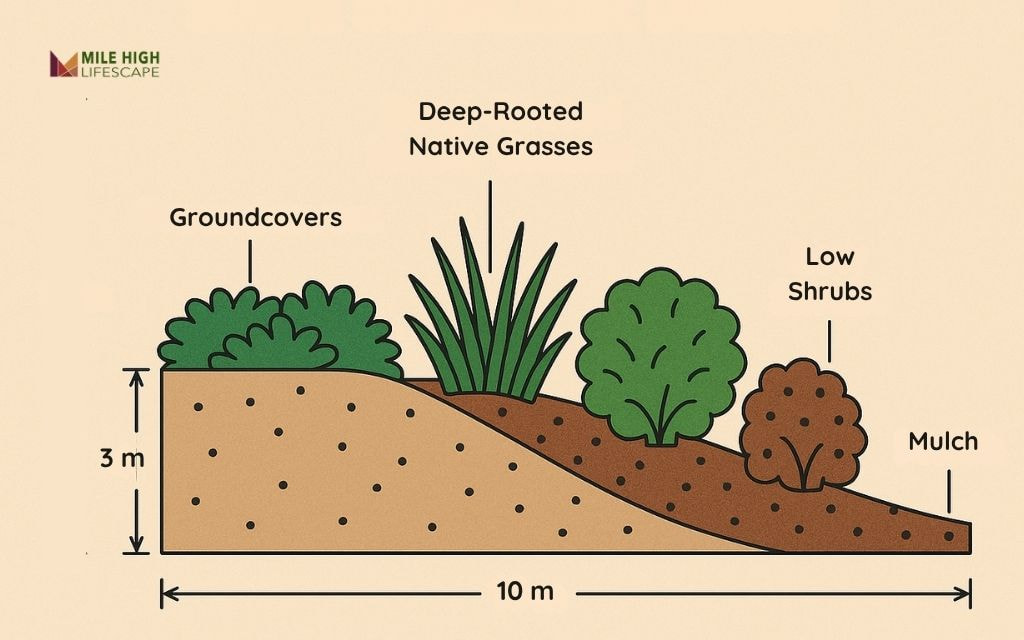
#6: Xeric Corner Lot with Privacy Focus
Corner lot properties often lack natural privacy screening, facing increased visibility from multiple directions. This template creates attractive borders that provide seclusion without appearing fortress-like or unfriendly.
Best For: Corner lots, properties adjacent to busy streets, or yards requiring noise buffering. The design suits homeowners who want privacy without sacrificing aesthetic appeal or neighborhood integration.
Tall shrub selections include Serviceberry, Oakleaf Sumac, and native Currants arranged in layered plantings that create visual barriers. The design incorporates viewing windows and varies heights to avoid monotonous screening walls.

#7: Native Grass + Boulder Front Yard Mix
Modern landscape aesthetics increasingly favor clean lines and minimalist plant palettes.
This template delivers contemporary appeal while celebrating Colorado’s natural grassland heritage through thoughtful design and material selection.
Best For: Homeowners preferring modern, low-maintenance landscapes with strong architectural elements. This design particularly suits contemporary home styles and owners who appreciate minimalist outdoor spaces.
The template combines ornamental boulders with native grass matrices, creating striking visual contrasts. Featured grasses include Little Bluestem, Buffalo Grass, and Blue Grama in geometric or flowing arrangements.

#8: Mixed Wildflower + Grass Meadow Plan
Large properties offer opportunities to apply many xeriscaping ideas and create naturalistic landscapes that mimic Colorado’s native ecosystems while providing habitat and seasonal drama.
This template recreates prairie conditions using proven plant combinations.
Best For: Large lots, rural properties, or homeowners wanting naturalistic landscapes that support wildlife populations. The design suits those who appreciate informal, meadow-like aesthetics over manicured garden styles.
Plant selections include native wildflowers like Penstemon, Blanket Flower, and Indian Blanket combined with structural grasses such as Little Bluestem and Side-oats Grama. The design creates flowing color masses that change throughout the growing season.
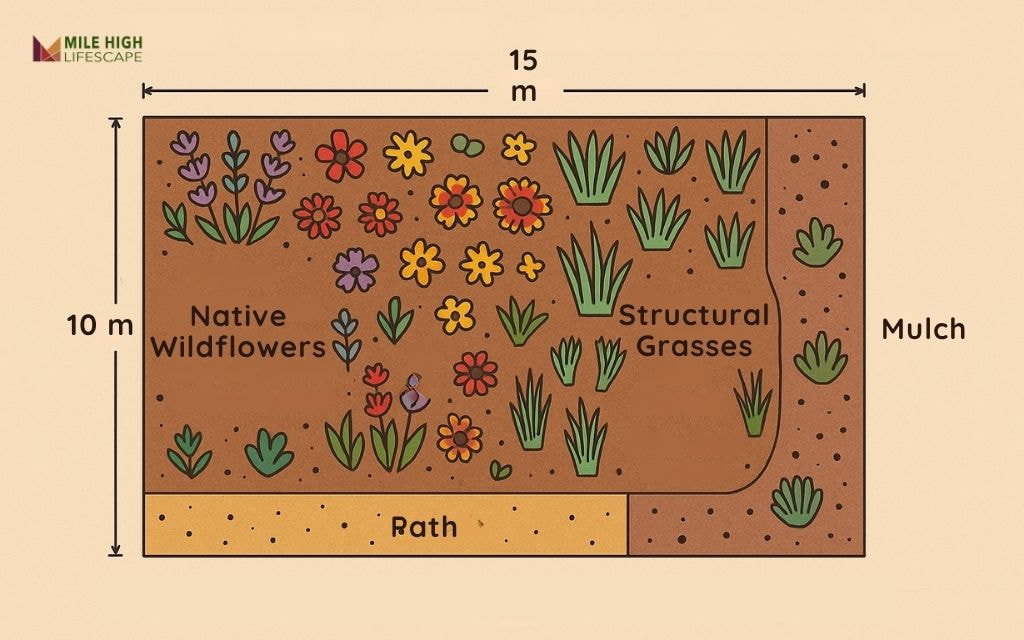
#9: Garden-In-A-Box Templates
These modular, pre-planned designs simplify xeriscaping for beginners by providing complete plant lists, spacing guides, and installation instructions. Each box covers 100-200 square feet with themed plant combinations.
Best For: First-time xeriscapers, renters wanting portable designs, or homeowners preferring step-by-step guidance. These templates work well for those who want professional results without extensive planning time.
Available themes include “Cool Season Color,” “Sunset Prairie,” and “Pollinator Paradise,” each featuring plant combinations that establish quickly and provide immediate impact.
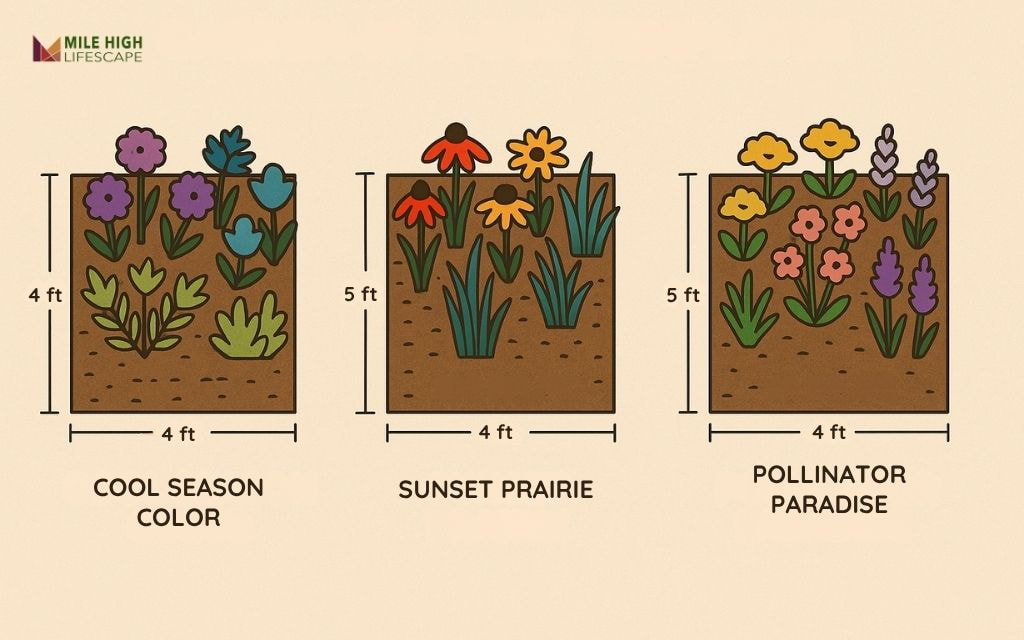
#10: Small Urban Yard Xeriscape Plan
Urban lots often feature challenging conditions including limited space, soil contamination, and microclimatic extremes. This template maximizes visual impact while addressing common urban gardening constraints.
Best For: Townhomes, condominiums, or compact urban lots where every square foot matters. The design suits homeowners dealing with typical urban challenges like poor soil, limited sun, and small growing areas.
The plan emphasizes vertical layering, container integration, and multi-season plants that provide maximum visual return on limited space investment. Featured species perform well in urban microclimates while requiring minimal water and maintenance inputs.
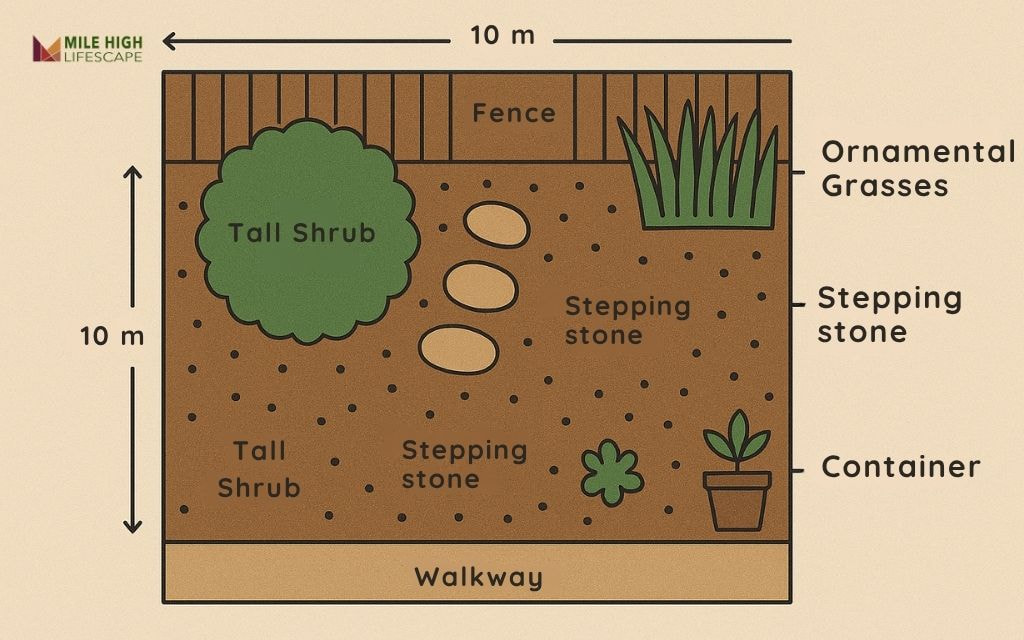
How to Choose the Right Xeriscape Design for Your Yard
Selecting the appropriate template requires honest assessment of your property’s physical conditions and your personal landscape goals.
- Start by documenting sun exposure patterns throughout your yard during different seasons, noting areas that receive full sun, partial shade, or deep shade conditions.
- Evaluate slope and drainage patterns by observing water movement during rain events. Properties with steep grades require erosion-control focused designs, while flat areas offer more flexible template options.
- Identify your landscape objectives before committing to specific templates. For example, homeowners prioritizing entertainment should select designs incorporating hardscape areas and comfortable sight lines. Those dealing with privacy concerns need templates that incorporate screening elements without creating fortress-like appearances.
- Measure your available planting area before selecting templates. Many designs specify square footage requirements, and attempting to compress large-scale templates into small spaces often produces disappointing results.
If you want to create your xeriscape DIY, check out our free guide about how to xeriscape your yard here!
If you’re looking for professional help from xeriscape companies near Denver, Mile High Lifescape is your way to go. Our experienced team can recommend template modifications or custom design solutions that ensure your xeriscaping investment delivers lasting beauty and water savings.
Conclusion
Xeriscape design templates eliminate the uncertainty that prevents many homeowners from embracing water-wise landscaping. These developed plans provide the structure and plant selection guidance needed to create stunning landscapes in Colorado.
Start your xeriscaping journey today with confidence, knowing that your chosen template has been tested and refined by Colorado’s leading landscape professionals.
Frequently Asked Questions (FAQs)
Can I modify a template to fit my oddly shaped yard?
Most xeriscape templates can be adapted to accommodate irregular lot shapes or unique site conditions. Focus on maintaining the recommended plant groupings and spacing ratios while adjusting the overall layout to fit your space.
Are these designs HOA-friendly?
The majority of developed xeriscape templates comply with standard HOA landscape requirements, particularly those emphasizing front yard curb appeal and maintained appearances. However, review your specific HOA guidelines before installation, as some associations maintain restrictions on plant types, mulch materials, or overall landscape styles.
Do the templates include plant care instructions?
Most comprehensive templates provide basic establishment care guidelines, including initial watering schedules, mulching recommendations, and first-year maintenance requirements. However, detailed ongoing care instructions vary by source. Supplement template information with guides from Colorado State University Extension or consult with local gardening experts for maintenance schedules and care requirements.
